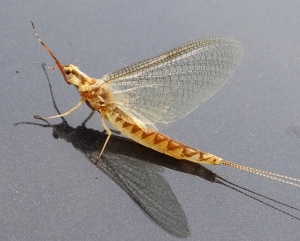
Burrowing mayfly (Ephemeroptera: Ephemeridae: Hexagenia sp.) photographed 06/28/2014 at Metzger Marsh east of Bono, Ohio.
The decline and rise of burrowing mayflies (Ephemeroptera: Ephemeridae: Hexagenia spp.) in western Lake Erie represents an excellent example of how humans have the capacity to both ruin and save the world. Although our pollution decimated these insects and disrupted food webs, ecosystems, and human quality of life for decades, our ability to curtail our reckless behavior helped restore what we had once nearly destroyed.
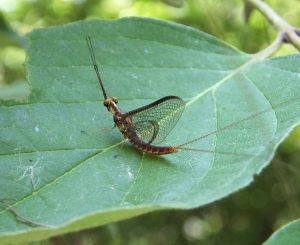
Burrowing mayfly (Ephemeroptera: Ephemeridae: Hexagenia sp.) photographed 06/28/2014 at Magee Marsh east of Bono, Ohio.
First, a little background. Burrowing mayflies are most often encountered near lakes and rivers throughout North America, especially in the east. The adults are relatively large flying insects that can swarm and mate by the millions. Their eggs hatch into aquatic nymphs that dig into lake and river sediment where they wait to ambush and eat other arthropods. After spending a sufficient amount of time feeding and growing, they molt into adults, take to the air to mate, and complete their life cycles. Along the way many are eaten by fish and other animals, making them both predator and prey in the middle of local food webs.
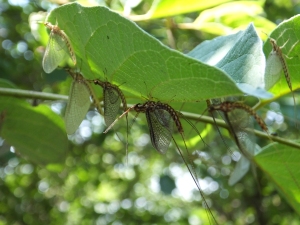
Burrowing mayflies (Ephemeroptera: Ephemeridae: Hexagenia sp.) photographed 06/28/2014 at Magee Marsh east of Bono, Ohio.
Historically large numbers of burrowing mayflies lived in and around the western basin of Lake Erie. During the first half of the twentieth century, however, unchecked water pollution generated by unprecedented municipal, agricultural, and industrial expansion wreaked havoc on the lake. All forms of contamination filled the water including raw sewage, phosphorous and nitrates from fertilizer, heavy metals like mercury, and organic compounds like PCBs. Pollutants and subsequent reduced oxygen levels extirpated many species including burrowing mayflies, and by the 1960s Lake Erie was declared “dead.” Contamination was so bad in tributaries like the Rouge and Cuyahoga Rivers that they literally caught fire more than once. Beaches became unfit for swimming, water supplies became unfit for drinking, and sport and commercial fish populations took a big hit.
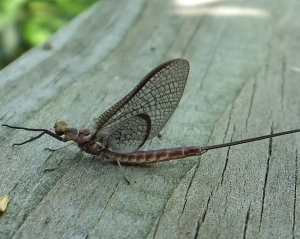
Burrowing mayfly (Ephemeroptera: Ephemeridae: Hexagenia sp.) photographed 06/28/2014 at Magee Marsh east of Bono, Ohio.
By the 1970s environmental and conservation movements had raised public awareness of pollution and its effects on our quality of life. Laws were enacted beginning in the 1970s to limit the amount of pollution released into our lakes and rivers. Throughout the 1980s water quality slowly improved. And then, by the 1990s, burrowing mayflies finally returned to western Lake Erie after a 40 year absence.
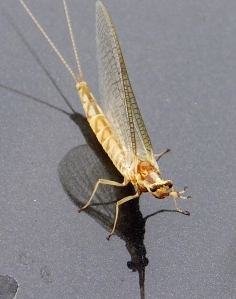
hexagenia5 Burrowing mayfly (Ephemeroptera: Ephemeridae: Hexagenia sp.) photographed 06/28/2014 at Metzger Marsh east of Bono, Ohio.
Today these “delightful nuisances” are a perennial phenomenon to be enjoyed and cursed by all. Their mating swarms again reach into the millions and are so dense that they appear on weather radar. Thousands of their bodies litter buildings and streets near the lake, simultaneously fascinating and disgusting the local populace. And not only do they adorn lakeside homes, they can be found spread out to 30 miles inland as well:
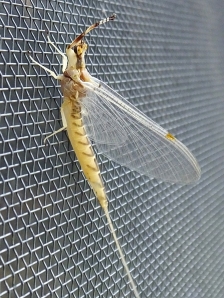
Burrowing mayfly (Ephemeroptera: Ephemeridae: Hexagenia sp.) photographed 07/13/2014 near Palmyra, Michigan.
Although the abundance of burrowing mayflies has become almost comical in recent years, their near-extermination and the effect on local ecosystems at the hands of human activity remain fresh and troubling memories. Our shameful behavior is to be abhored, to be sure, but our ability to reverse our actions is a sign of encouragement. If we can undo the damage we caused to the Great Lakes, surely we have it in us to undo the damage we have caused elsewhere.

Living near Lake Erie, I learned something..thank you… Michelle
LikeLike
Reblogged this on Will S.' Sunny Side Blog and commented:
Good news, indeed.
LikeLike